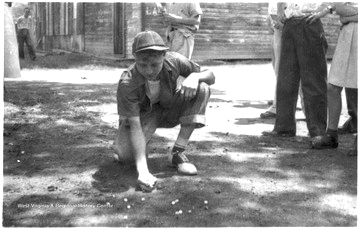Older readers may remember when school recess meant games of marbles. Students would rush out with bags of marbles, draw a circle in the dirt, and commence a game. Each player would put in the same number of marbles in the circle. Using a shooting marble, the objective was to knock the opponent’s marbles out of the circle. In some versions of the game, when a shooter knocked his opponent’s marble out of the circle, he kept the marble. The 1947 photo above shows John Ashcraft, marble king of Harrison County, WV (note his saddle oxfords).
Marbles have been around for thousands of years. Clay balls have been found in Egyptian tombs, Native American burial mounds, and Aztec pyramids. The first book about marbles was printed in 1815 and described them as being made of china, clay, glass or real marble. In 1848, a German glass blower made the first mold for marbles. In 1890, the first machine made marbles were offered. The first marble manufacturing in the United States may have started in 1915 when the Akron Agate Company, an importer of German marbles, opened a factory in West Virginia. Founded in 1929 in Ravenswood, WV, the Ravenswood Novelty Company produced around 100 million marbles per year. At one time there were at least seven companies making marbles in West Virginia. However, in 1950 the Japanese created the colorful cat’s eye marbles and flooded the market causing most of the United States manufacturers to fold. Today, Marble King in Paden City is the sole WV manufacturer.
While playing marbles is not the past time it once was, the National Marbles Tournament has been held annually since 1922 in Wildwood, NJ. It is a four-day event with 1,200 games played. Over the years, the tournament has awarded thousands of college scholarships to participants.
Photo: Courtesy of West Virginia University Regional History Center.
Sources: imarbles.com, The Museum of American Glass in WV, Los Angeles Times, Arizona Historical Society.



